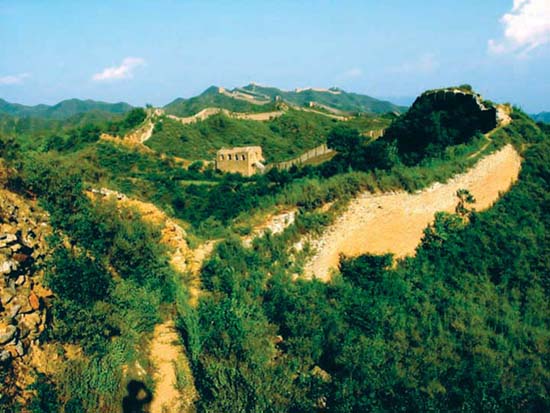
|
|
Gubeikou is one of the world cultural heritages. [Photo/gbk.bjmy.gov.cn]
|
I saw images of the Sisters Beacon Towers – the lower one nestling against the taller one – beside the Chaohe River, villages that were bombed by the Japanese army, queues of Chinese and Japanese soldiers and even the Comfort Women, women and girls forced into prostitution by the Japanese army during WWII. As I watched the still pictures in the simplest of ways, I found I was sitting among the same backdrops as in the photos. It felt like a giant history book had been opened up in front of me.
Pang didn’t utter a word from the very beginning. He then showed me a picture that I would never forget – a rusty bullet embedded in a brick of the Gubeikou Great Wall. Closer inspection of the bricks near where we were sitting revealed many shallow craters left by bullets, calling cards from history. When I saw that picture I felt as if I had been shot by the bullet. I felt disoriented amid the mountain ranges extending into the night. I pictured that segment of the Great Wall suffering a hail of bullets and the number of casualties of the bloody battles. At that moment, I understood what the old residents of the villages had said and I, too, felt I could hear the roaring on the battlefield from afar.
Historical Significance
In my opinion, Gubeikou is the most beautiful section of the Great Wall in Beijing. The Wohu (Crouching Tiger) Mountain towers above while the ridge of the Panlong (Curling Dragon) Mountain snakes along. The Gubeikou Great Wall is divided into two segments by the Chaohe River. Every brick in those dilapidated walls, crude and unadorned, has the power to transport visitors back to the old times and lets them feel the Great Wall’s majesty endowed by history.
With continuing social development, excessive renovation and reconstruction can often mask the true face of history. From that perspective, the Gubeikou Great Wall is rare and precious because this section of the wall is as history left it, unrestored.
The history of Gubeikou can be divided into three phases.
The first phase goes back to the period when the Song Dynasty fought the Jin regime of Jurchens (from the end of the 10th century to the beginning of the 11th century). The story that the warriors of the Yang family defended northern China is a classic that has been passed from generation to generation till today. Three generations of the family’s men had been commanders of the Song army, defending Song’s northern border. One of them died at the Gubeikou Great Wall, and it is said his tomb lies on the Wohu Mountain.
The second phase is charted during the Wanli Period of the Ming Dynasty from 1573 to 1620. At that time, Qi Jiguang, a famous militarist, was entrusted to build the Great Wall in Gubeikou and he personally participated in its construction. The segment of the wall that he oversaw is incomparable in terms of sturdiness and ingenuity. Today, a stele that marked Qi’s effort in building the Gubeikou Great Wall is preserved in the town’s exhibition hall. And an awe-inspiring statue of Qi stands high on Gubeikou Square.
The third phase is the war against Japanese intrusion in the 1930s. The Kuomintang 17th Corps launched a bloody battle in Gubeikou in 1933 to prevent the Japanese army invading Beijing.
We Recommend:
